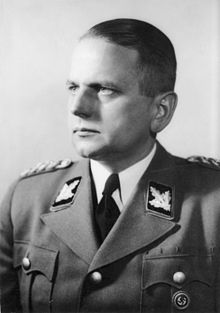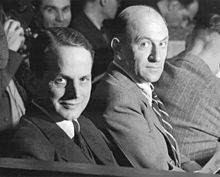Otto Ohlendorf: Difference between revisions
Wikievil666 (talk | contribs) m →Third Reich: Removed redundant 'Under his command, ' since ' Ohlendorf's' means the same. |
|||
| Line 44: | Line 44: | ||
{{trivia|date=January 2009}} |
{{trivia|date=January 2009}} |
||
[[NSDAP]] # |
[[NSDAP]] # 6531 – joined on 28 May 1925 (Note: some sources, including the top of this article, report #6631)<br> |
||
[[SS]] # 880 – joined on 28 May 1925 |
[[SS]] # 880 – joined on 28 May 1925 |
||
Revision as of 08:17, 24 May 2010
Otto Ohlendorf | |
|---|---|
 SS-Brigadeführer Otto Ohlendorf | |
| Allegiance | |
| Service/ | Waffen SS |
| Years of service | 1925 - 1945 |
| Rank | SS-Gruppenführer und Generalleutnant der Polizei |
| Commands | Einsatzgruppe D Amt III, RSHA |
| Battles/wars | World War II |
| Awards | War Merit Cross I class |
Dr. Otto Ohlendorf (4 February 1907 – 7 June 1951) was a German SS-Gruppenführer and head of the interior division of the SD. He was convicted of and executed for war crimes committed during World War II.
Biography
Early life
Born in Hoheneggelsen near Hildesheim, the son of farm owners, he joined the Nazi party in 1925 (member #6631) followed by the SS in 1926. Ohlendorf studied Economics and Law at the University of Leipzig and the University of Göttingen, and by 1930 was already giving lectures at several economic institutions.
Third Reich

In early 1936, he became an economic consultant to the SD, attached to the SS with the rank of SS-Hauptsturmführer. In May 1936, he was promoted to SS-Sturmbannführer and took a senior post. In 1939, he was once again promoted to SS-Standartenführer and appointed as head of Amt III of the Reichssicherheitshauptamt, a position he kept until 1945. In addition, from 1943 onwards, Ohlendorf was appointed as deputy director general of the Reich Ministry of Economic Affairs, and promoted once more in 1944 to Gruppenführer.
In June 1941, Reinhard Heydrich appointed Ohlendorf to be commander of Einsatzgruppe D which operated in southern Ukraine and Crimea. Ohlendorf's Einsatzgruppe would be responsible for the 13 December 1941 massacre at Simferopol where at least 14,300 people, mostly Jews, were executed. Over 90,000 executions are attributed to Ohlendorf's command, who testified to this effect during his trial at Nuremberg.
At the end of 1943, Ohlendorf, in addition to his other jobs, became deputy secretary of state in the Reichsministerium für Wirtschaft (Reichs-Ministry for Economics). He coordinated plans to rebuild the German economy after the war, a war he and others believed to be lost. Such planning for the post-war time was strictly forbidden - on one side. On the other side, Heinrich Himmler, who detested the state interventionist regime of Albert Speer as "totally bolshevik" and was himself hoping for a career in a militarily defeated Germany, protected the working group around Ohlendorf and Ludwig Erhard and other experts, who planned how to introduce the new German currency Deutsche Mark, among other things. Ohlendorf himself spoke out for "active and courageous entrepreneurship (aktives und wagemutiges Unternehmertum)", which was intended to replace bureaucratic state planning of the economy after the war.
Because of Ohlendorf's work in this field, many petitions for leniency were filed after he was sentenced to death by hanging. These, however, were turned down by the Allies.[1]

Nuremberg War Trials
During the trial against Einsatzgruppen leaders, Ohlendorf was the chief defendant, and was also a key witness in the prosecution of many other indicted war criminals. Ohlendorf's frank, apparently reliable testimony was attributed to his distaste for the corruption that was rampant in Nazi Germany and a stubborn commitment to duty. He expressed no remorse for his actions, telling the prosecutor that the Jews of America would suffer for what the prosecutor had done, and seemed to have been more concerned about the moral strain on those carrying out the executions than those actually being executed.[2][3]
Otto Ohlendorf was sentenced to death and hanged at the Landsberg Prison in Bavaria on 7 June 1951.
Other information
This article contains a list of miscellaneous information. (January 2009) |
NSDAP # 6531 – joined on 28 May 1925 (Note: some sources, including the top of this article, report #6631)
SS # 880 – joined on 28 May 1925
Portrayal in popular culture
- Ohlendorf appears at length in Jonathan Littell's docudrama Les Bienveillantes.
- Ohlendorf was portrayed by Christopher James in the 2006 British television docudrama Nuremberg: Nazis on Trial[4]
- Ohlendorf was portrayed by Nigel Hawthorne in the miniseries "Holocaust" (1978)
Notes
- ^ See also Michael Brackmann in Handelsblatt, June 2006.
- ^ Benjamin B. Frencz: Nuremberg Trials and Tributions
- ^ Benjamin B. Frencz: Mass Murderers Seek to Justify Genocide
- ^ "Nuremberg: Nazis on Trial (2006) (TV)". IMDb.com. Retrieved May 20, 2008.
{{cite web}}: Cite has empty unknown parameter:|coauthors=(help)
http://www.law.umkc.edu/faculty/projects/ftrials/nuremberg/Ohlentestimony.html
References
- Michael Brackmann: Der Tag X. - Im Juni 1948 kommt die D-Mark und verändert das Land. Die Währungsreform ist von langer Hand vorbereitet und bis ins Detail ausgetüftelt worden. In: Handelsblatt 23./24./25. June 2006. In English: "The day X. - In June 1948 the Deutschmark is introduced and this changes the country. The currency reform has been prepared for a long time and had been subtly and punctiliously prepared in detail in advance." The article claims a collaboration between Otto Ohlendorf and Ludwig Erhard and other experts in preparing the post war economy with collusion and protection by Heinrich Himmler.
- Articles with trivia sections from January 2009
- 1907 births
- 1951 deaths
- People from the District of Hildesheim
- Executions by the United States Nuremberg Military Tribunals
- Holocaust perpetrators
- Nazis convicted of war crimes
- People executed by hanging
- SS generals
- Executed German people
- Einsatzgruppen personnel
- The Holocaust in Ukraine
- The Holocaust in Russia
- Executed Nazis
